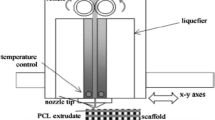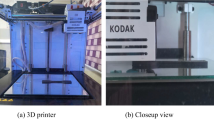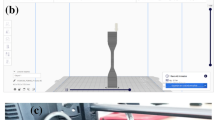Abstract
Fused depositional modeling (FDM) is one of the common methods for 3D printing of polymers, which is expanding in various industrial applications, scientific researches, and engineering applications due to its ability to make complex parts. In this research, molecular dynamics (MDs) simulation has been used to predict the physical and mechanical properties. Then, the mechanical properties of the printed parts were determined. The mechanical properties of 3D printed parts strongly depend on the correct selection of processing parameters. In this study, the effect of three important parameters such as infill density, printing speed, and layer thickness were investigated on the tensile properties of PLA specimens. For this purpose, standard specimens with four infill densities of 20%, 40%, 60%, and 80%, two speeds of 20 mm/s and 40 mm/s, and two thicknesses of 0.1 mm and 0.2 mm were printed and tested under quasi-static tensile test. In all printed specimens, the print angle is ± 45°. The obtained experimental outcomes from the tensile test revealed that with increasing the infilling density, the mechanical properties of the parts improve and increase significantly. However, at very high infilling densities, the samples behave more brittle, so in cases where the strength of the part is less important than its shape and appearance, a density of 40% is more suitable in terms of cost, material, and time savings. It was also noted that the printing speed has less effect on the mechanical properties of PLA parts. It was also observed that reducing the thickness of the layer, while slightly increasing the stiffness of the parts, makes the part extremely brittle, and on the other hand, it leads to increase in the dimensional accuracy and surface quality of the specimens. At infill density of 80%, the specimens had the highest stiffness and strength, but it exhibits a brittle behavior. Moreover, it can be deduced that by reducing the layer thickness although the modulus of elasticity increases a little, ductility is greatly affected.


















Similar content being viewed by others
Data availability
Data required to reproduce these findings have been given in the text.
References
Pappas JM, Thakur AR, Leu MC, Dong X (2021) A parametric study and characterization of additively manufactured continuous carbon fiber reinforced composites for high-speed 3D printing. Int J Adv Manuf Technol 113:2137–2151. https://doi.org/10.1007/s00170-021-06723-1
Wang Y-C, Chen T, Yeh Y-L (2019) Advanced 3D printing technologies for the aircraft industry: a fuzzy systematic approach for assessing the critical factors. Int J Adv Manuf Technol 105:4059–4069. https://doi.org/10.1007/s00170-018-1927-8
Chen T, Wang Y-C (2019) An advanced IoT system for assisting ubiquitous manufacturing with 3D printing. Int J Adv Manuf Technol 103:1721–1733. https://doi.org/10.1007/s00170-019-03691-5
Velu R, Vaheed N, Ramachandran MK, Raspall F (2020) Correction to: Experimental investigation of robotic 3D printing of high-performance thermoplastics (PEEK): a critical perspective to support automated fibre placement process. Int J Adv Manuf Technol 108:1027–1027. https://doi.org/10.1007/s00170-019-04763-2
Farazin A, Sahmani S, Soleimani M, Kolooshani A, Saber-Samandari S, Khandan A (2021) Effect of hexagonal structure nanoparticles on the morphological performance of the ceramic scaffold using analytical oscillation response. Ceram Int 47:18339–18350. https://doi.org/10.1016/j.ceramint.2021.03.155
Ayrilmis N (2018) Effect of layer thickness on surface properties of 3D printed materials produced from wood flour/PLA filament. Polym Test 71:163–166. https://doi.org/10.1016/j.polymertesting.2018.09.009
Hedayati SK, Behravesh AH, Hasannia S, Bagheri Saed A, Akhoundi B (2020) 3D printed PCL scaffold reinforced with continuous biodegradable fiber yarn: a study on mechanical and cell viability properties. Polym Test 83:106347. https://doi.org/10.1016/j.polymertesting.2020.106347
Chen S, Hassanzadeh-Aghdam MK, Ansari R (2018) An analytical model for elastic modulus calculation of SiC whisker-reinforced hybrid metal matrix nanocomposite containing SiC nanoparticles. J Alloys Compd 767:632–641. https://doi.org/10.1016/j.jallcom.2018.07.102
Mou B, Zhao F, Qiao Q, Wang L, Li H, He B, Hao Z (2019) Flexural behavior of beam to column joints with or without an overlying concrete slab. Eng Struct 199:109616. https://doi.org/10.1016/j.engstruct.2019.109616
Mou B, Li X, Bai Y, Wang L (2019) Shear behavior of panel zones in steel beam-to-column connections with unequal depth of outer annular stiffener. J Struct Eng 145:04018247. https://doi.org/10.1061/(ASCE)ST.1943-541X.0002256
Lin J, Wang Y, Wei X, Kong S, Liu Z, Liu JJ, Zhang F, Lin S, Ji B, Zhou Z, Guo Z (2020) Controllable antibacterial and bacterially anti-adhesive surface fabricated by a bio-inspired beetle-like macromolecule. Int J Biol Macromol 157:553–560. https://doi.org/10.1016/j.ijbiomac.2020.04.207
Lin J, Cai X, Liu Z, Liu N, Xie M, Zhou BP, Wang H, Guo Z (2020) Anti-liquid-interfering and bacterially antiadhesive strategy for highly stretchable and ultrasensitive strain sensors based on Cassie-Baxter wetting state. Adv Funct Mater 30:2000398. https://doi.org/10.1002/adfm.202000398
Yang Z, Xu P, Wei W, Gao G, Zhou N, Wu G (2020) Influence of the crosswind on the pantograph arcing dynamics. IEEE Trans Plasma Sci 48:2822–2830. https://doi.org/10.1109/TPS.2020.3010553
Liu C, Wang F, He L, Deng X, Liu J, Wu Y (2020) Experimental and numerical investigation on dynamic responses of the umbrella membrane structure excited by heavy rainfall J Vib Control 107754632093269. https://doi.org/10.1177/1077546320932691
Liu C, Wang F, Deng X, Pang S, Liu J, Wu Y, Xu Z (2021) Hailstone-induced dynamic responses of pretensioned umbrella membrane structure. Adv Struct Eng 24:3–16. https://doi.org/10.1177/1369433220940149
Liu C, Deng X, Liu J, Peng T, Yang S, Zheng Z (2020) Dynamic response of saddle membrane structure under hail impact. Eng Struct 214:110597. https://doi.org/10.1016/j.engstruct.2020.110597
Zuo C, Chen Q, Tian L, Waller L, Asundi A (2015) Transport of intensity phase retrieval and computational imaging for partially coherent fields: The phase space perspective. Opt Lasers Eng 71:20–32. https://doi.org/10.1016/j.optlaseng.2015.03.006
Guo L, Qiu J (2018) Combination of cloud manufacturing and 3D printing: research progress and prospect. Int J Adv Manuf Technol 96:1929–1942. https://doi.org/10.1007/s00170-018-1717-3
Khosravani MR, Zolfagharian A, Jennings M, Reinicke T (2020) Structural performance of 3D-printed composites under various loads and environmental conditions. Polym Test 91:106770. https://doi.org/10.1016/j.polymertesting.2020.106770
Aziz R, Ul Haq MI, Raina A (2020) Effect of surface texturing on friction behaviour of 3D printed polylactic acid (PLA). Polym Test 85:106434. https://doi.org/10.1016/j.polymertesting.2020.106434
Alam Z, Sun L, Zhang C, Su Z, Samali B (2021) Experimental and numerical investigation on the complex behaviour of the localised seismic response in a multi-storey plan-asymmetric structure. Struct Infrastruct Eng 17:86–102. https://doi.org/10.1080/15732479.2020.1730914
Zhang C, Wang H (2020) Swing vibration control of suspended structures using the Active Rotary Inertia Driver system: theoretical modeling and experimental verification. Struct Control Heal Monit 27:27. https://doi.org/10.1002/stc.2543
Zhang C, Gholipour G, Mousavi AA (2020) State-of-the-art review on responses of RC structures subjected to lateral impact loads. Arch Comput Methods Eng. https://doi.org/10.1007/s11831-020-09467-5
Abedini M, Zhang C (2020) Performance assessment of concrete and steel material models in LS-DYNA for enhanced numerical simulation, a state of the art review. Arch Comput Methods Eng. https://doi.org/10.1007/s11831-020-09483-5
Liu S, Yu W, Chan FTS, Niu B (2021) A variable weight-based hybrid approach for multi-attribute group decision making under interval-valued intuitionistic fuzzy sets. Int J Intell Syst 36:1015–1052. https://doi.org/10.1002/int.22329
Zhan J, Tamura T, Li X, Ma Z, Sone M, Yoshino M, Umezu S, Sato H (2020) Metal-plastic hybrid 3D printing using catalyst-loaded filament and electroless plating. Addit Manuf 36:101556. https://doi.org/10.1016/j.addma.2020.101556
Xu J, Zhang X, Liu Y, Zhang Y, Nie HY, Zhang G, Gao W (2020) Selective coaxial ink 3D printing for single-pass fabrication of smart elastomeric foam with embedded stretchable sensor. Addit Manuf 36:101487. https://doi.org/10.1016/j.addma.2020.101487
Maurel A, Haukka M, MacDonald E, Kivijärvi L, Lahtinen E, Kim H, Armand M, Cayla A, Jamali A, Grugeon S, Dupont L, Panier S (2021) Considering lithium-ion battery 3D-printing via thermoplastic material extrusion and polymer powder bed fusion. Addit Manuf 37:101651. https://doi.org/10.1016/j.addma.2020.101651
Choi S, Ryu J, Lee M, Cha J, Kim H, Song C, Kim DS (2020) Support-free hollowing with spheroids and efficient 3D printing utilizing circular printing motions based on Voronoi diagrams. Addit Manuf 35:101254. https://doi.org/10.1016/j.addma.2020.101254
Kim D, Lee J, Kim G (2020) Biomimetic gelatin/HA biocomposites with effective elastic properties and 3D-structural flexibility using a 3D-printing process. Addit Manuf 36:101616. https://doi.org/10.1016/j.addma.2020.101616
Tu R, Sprague E, Sodano HA (2020) Precipitation printing towards diverse materials, mechanical tailoring and functional devices. Addit Manuf 35:101358. https://doi.org/10.1016/j.addma.2020.101358
Singh G, Missiaen J-M, Bouvard D, Chaix J-M (2021) Copper extrusion 3D printing using metal injection moulding feedstock: analysis of process parameters for green density and surface roughness optimization. Addit Manuf 38:101778. https://doi.org/10.1016/j.addma.2020.101778
Dong Q, Cui L (2021) Reliability analysis of a system with two-stage degradation using Wiener processes with piecewise linear drift. IMA J Manag Math 32:3–29. https://doi.org/10.1093/imaman/dpaa009
Zuo C, Chen Q, Gu G, Feng S, Feng F, Li R, Shen G (2013) High-speed three-dimensional shape measurement for dynamic scenes using bi-frequency tripolar pulse-width-modulation fringe projection. Opt Lasers Eng 51:953–960. https://doi.org/10.1016/j.optlaseng.2013.02.012
Hu Y, Chen Q, Feng S, Zuo C (2020) Microscopic fringe projection profilometry: a review. Opt Lasers Eng 135:106192. https://doi.org/10.1016/j.optlaseng.2020.106192
Zhang J, Sun J, Chen Q, Zuo C (2020) Resolution analysis in a lens-free on-chip digital holographic microscope. IEEE Trans Comput Imaging 6:697–710. https://doi.org/10.1109/TCI.2020.2964247
Zhang J, Chen Q, Sun J, Tian L, Zuo C (2020) On a universal solution to the transport-of-intensity equation. Opt Lett 45:3649. https://doi.org/10.1364/OL.391823
Kanakannavar S, Pitchaimani J (2021) Fracture toughness of flax braided yarn woven PLA composites. Int J Polym Anal Charact 26:364–379. https://doi.org/10.1080/1023666X.2021.1892424
Goel V, Luthra P, Kapur GS, Ramakumar SSV (2021) Biodegradable/bio-plastics: myths and realities. J Polym Environ. https://doi.org/10.1007/s10924-021-02099-1
Li C, Sun L, Xu Z, Wu X, Liang T, Shi W (2020) Experimental investigation and error analysis of high precision FBG displacement sensor for structural health monitoring. Int J Struct Stab Dyn 20:2040011. https://doi.org/10.1142/S0219455420400118
Zhang C, Gholipour G, Mousavi AA (2020) Blast loads induced responses of RC structural members: state-of-the-art review. Compos Part B Eng 195:108066. https://doi.org/10.1016/j.compositesb.2020.108066
Alam Z, Zhang C, Samali B (2020) Influence of seismic incident angle on response uncertainty and structural performance of tall asymmetric structure. Struct Des Tall Spec Build 29. https://doi.org/10.1002/tal.1750
Zhang C, Abedini M, Mehrmashhadi J (2020) Development of pressure-impulse models and residual capacity assessment of RC columns using high fidelity Arbitrary Lagrangian-Eulerian simulation. Eng Struct 224:111219. https://doi.org/10.1016/j.engstruct.2020.111219
Zhu L, Kong L, Zhang C (2020) Numerical study on hysteretic behaviour of horizontal-connection and energy-dissipation structures developed for prefabricated shear walls. Appl Sci 10:1240. https://doi.org/10.3390/app10041240
Croccolo D, De Agostinis M, Olmi G (2013) Experimental characterization and analytical modelling of the mechanical behaviour of fused deposition processed parts made of ABS-M30. Comput Mater Sci 79:506–518. https://doi.org/10.1016/j.commatsci.2013.06.041
Tymrak BM, Kreiger M, Pearce JM (2014) Mechanical properties of components fabricated with open-source 3-D printers under realistic environmental conditions. Mater Des 58:242–246. https://doi.org/10.1016/j.matdes.2014.02.038
Chacón JM, Caminero MA, García-Plaza E, Núñez PJ (2017) Additive manufacturing of PLA structures using fused deposition modelling: effect of process parameters on mechanical properties and their optimal selection. Mater Des 124:143–157. https://doi.org/10.1016/j.matdes.2017.03.065
Kozior T, Kundera C (2017) Evaluation of the influence of parameters of FDM technology on the selected mechanical properties of models. Procedia Eng 192:463–468. https://doi.org/10.1016/j.proeng.2017.06.080
Mahmood S, Qureshi AJ, Goh KL, Talamona D (2017) Tensile strength of partially filled FFF printed parts: experimental results. Rapid Prototyp J 23:122–128. https://doi.org/10.1108/RPJ-08-2015-0115
Alafaghani A, Qattawi A, Alrawi B, Guzman A (2017) Experimental optimization of fused deposition modelling processing parameters: a design-for-manufacturing approach. Procedia Manuf 10:791–803. https://doi.org/10.1016/j.promfg.2017.07.079
Tronvoll SA, Elverum CW, Welo T (2018) Dimensional accuracy of threads manufactured by fused deposition modeling. Procedia Manuf 26:763–773. https://doi.org/10.1016/j.promfg.2018.07.088
Popescu D, Zapciu A, Amza C, Baciu F, Marinescu R (2018) FDM process parameters influence over the mechanical properties of polymer specimens: a review. Polym Test 69:157–166. https://doi.org/10.1016/j.polymertesting.2018.05.020
Khandan A, Saber-Samandari S, Telloo M, et al (2020) A mitral heart valve prototype using sustainable polyurethane polymer: fabricated by 3D bioprinter, tested by molecular dynamics simulation. AUT J Mech Eng
Oksman K, Skrifvars M, Selin J-F (2003) Natural fibres as reinforcement in polylactic acid (PLA) composites. Compos Sci Technol 63:1317–1324. https://doi.org/10.1016/S0266-3538(03)00103-9
Letcher T, Waytashek M (2014) Material property testing of 3D-printed specimen in PLA on an entry-level 3D printer. In: Volume 2A: Advanced Manufacturing. American Society of Mechanical Engineers
Rezgui F, Swistek M, Hiver JM, G'Sell C, Sadoun T (2005) Deformation and damage upon stretching of degradable polymers (PLA and PCL). Polymer (Guildf) 46:7370–7385. https://doi.org/10.1016/j.polymer.2005.03.116
Maroufkhani M, Katbab A, Liu W, Zhang J (2017) Polylactide (PLA) and acrylonitrile butadiene rubber (NBR) blends: the effect of ACN content on morphology, compatibility and mechanical properties. Polymer (Guildf) 115:37–44. https://doi.org/10.1016/j.polymer.2017.03.025
Torre R, Brischetto S, Dipietro IR (2021) Buckling developed in 3D printed PLA cuboidal samples under compression: analytical, numerical and experimental investigations. Addit Manuf 38:101790. https://doi.org/10.1016/j.addma.2020.101790
Ferrández-Montero A, Lieblich M, Benavente R, González-Carrasco JL, Ferrari B (2020) Study of the matrix-filler interface in PLA/Mg composites manufactured by material extrusion using a colloidal feedstock. Addit Manuf 33:101142. https://doi.org/10.1016/j.addma.2020.101142
Romeijn T, Wells B, Wei D, Paul G (2020) Investigation into the shear property of thin-walled additively manufactured structures using staggered fused filament fabrication. Addit Manuf 35:101259. https://doi.org/10.1016/j.addma.2020.101259
Farazin A, Aghdam HA, Motififard M, et al (2019) A polycaprolactone bio-nanocomposite bone substitute fabricated for femoral fracture approaches: molecular dynamic and micro-mechanical Investigation. J Nanoanalysis
Farazin A, Aghadavoudi F, Motififard M, et al (2020) Nanostructure, molecular dynamics simulation and mechanical performance of PCL membranes reinforced with antibacterial nanoparticles. J Appl Comput Mech
Farazin A, Mohammadimehr M (2020) Nano research for investigating the effect of SWCNTs dimensions on the properties of the simulated nanocomposites: a molecular dynamics simulation. Adv nano Res 9:83–90
Arh M, Slavič J, Boltežar M (2020) Experimental identification of the dynamic piezoresistivity of fused-filament-fabricated structures. Addit Manuf 36:101493. https://doi.org/10.1016/j.addma.2020.101493
Farazin A, Mohammadimehr M (2021) Computer modeling to forecast accurate of efficiency parameters of different size of graphene platelet, carbon, and boron nitride nanotubes: a molecular dynamics simulation. Comput Concr 27:111
Tanikella NG, Wittbrodt B, Pearce JM (2017) Tensile strength of commercial polymer materials for fused filament fabrication 3D printing. Addit Manuf 15:40–47. https://doi.org/10.1016/j.addma.2017.03.005
Lee C-Y, Liu C-Y (2019) The influence of forced-air cooling on a 3D printed PLA part manufactured by fused filament fabrication. Addit Manuf 25:196–203. https://doi.org/10.1016/j.addma.2018.11.012
Kakanuru P, Pochiraju K (2020) Moisture ingress and degradation of additively manufactured PLA, ABS and PLA/SiC composite parts. Addit Manuf 36:101529. https://doi.org/10.1016/j.addma.2020.101529
Camargo JC, Machado ÁR, Almeida EC, Silva EFMS (2019) Mechanical properties of PLA-graphene filament for FDM 3D printing. Int J Adv Manuf Technol 103:2423–2443. https://doi.org/10.1007/s00170-019-03532-5
Choi WJ, Hwang KS, Kwon HJ, Lee C, Kim CH, Kim TH, Heo SW, Kim JH, Lee JY (2020) Rapid development of dual porous poly(lactic acid) foam using fused deposition modeling (FDM) 3D printing for medical scaffold application. Mater Sci Eng C 110:110693. https://doi.org/10.1016/j.msec.2020.110693
Hu Q, Zhang R, Zhang H, Yang D, Liu S, Song Z, Gu Y, Ramalingam M (2021) Topological structure design and fabrication of biocompatible PLA/TPU/ADM mesh with appropriate elasticity for hernia repair. Macromol Biosci 2000423:2000423. https://doi.org/10.1002/mabi.202000423
Cheng YQ, Cao AJ, Ma E (2009) Correlation between the elastic modulus and the intrinsic plastic behavior of metallic glasses: the roles of atomic configuration and alloy composition. Acta Mater 57:3253–3267. https://doi.org/10.1016/j.actamat.2009.03.027
Krupa I, Cecen V, Boudenne A, Prokeš J, Novák I (2013) The mechanical and adhesive properties of electrically and thermally conductive polymeric composites based on high density polyethylene filled with nickel powder. Mater Des 51:620–628. https://doi.org/10.1016/j.matdes.2013.03.067
Acknowledgements
The authors would like to thank the referees for their valuable comments. Also, they are thankful to the Iranian Nanotechnology Development Committee for their financial support and the University of Kashan for supporting this work by Grant No. 988093/13 and the micro and nanomechanics laboratory by Grant No. 992020/2. Moreover, the authors would like to thank Entekhab Industrial Group as well as Alton Engineering and Technology Company for their contribution to the success of this article.
Funding
The authors have been received financial support for the research, authorship, and publication of this article at University of Kashan by Grant No. 988093/14 and the micro and nanomechanics laboratory by Grant No. 992020/2.
Author information
Authors and Affiliations
Contributions
Ashkan Farazin performed the experimental and MDs calculations. Dr. Mehdi Mohammadimehr guided Mr. Farazin in this work as supervisor and proof the language of the manuscript. Authors contributing to the final version of the manuscript.
Corresponding author
Ethics declarations
Ethics approval
Not applicable
Consent to participate
Not applicable
Consent for publication
The article is approved by all authors for publication.
Competing interest
The authors declare no competing interests.
Additional information
Publisher’s note
Springer Nature remains neutral with regard to jurisdictional claims in published maps and institutional affiliations.
Rights and permissions
About this article
Cite this article
Farazin, A., Mohammadimehr, M. Effect of different parameters on the tensile properties of printed Polylactic acid samples by FDM: experimental design tested with MDs simulation. Int J Adv Manuf Technol 118, 103–118 (2022). https://doi.org/10.1007/s00170-021-07330-w
Received:
Accepted:
Published:
Issue Date:
DOI: https://doi.org/10.1007/s00170-021-07330-w




